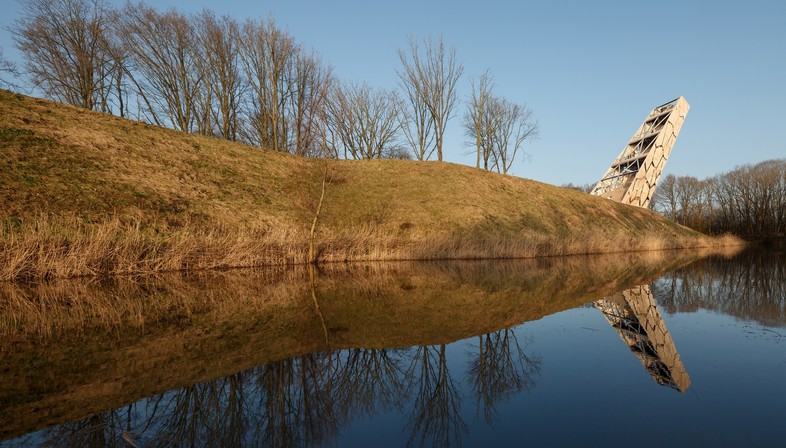27-02-2019
RO&AD Architecten’s Pompejus
katja吞噬,
Halsteren, Paesi Bassi,

In the south of the Netherlands, near the Belgian border, is Fort de Roovere, built in 1672 to defend the navigable waters against the French and Spanish, which became the theatre of battles for the control of this strategic location over the centuries. RO&AD, an architectural practice named after founders Ro Koster and Ad Kil, built Pompejus, a complex including a panoramic tower, a theatre and a tourist information centre. It is the latest in a series of projects implemented since 2010 for redevelopment of the fort area, which fell into decline in the 20th century when commercial traffic was redirected elsewhere.
Why build a panoramic tower in the middle of the Dutch lowlands? This is where the West Brabantse Defence Line is located: the first defence line in the world to use flooding for defensive purposes, blocking the enemy army’s passage. The line consists of a series of forts, of which Fort de Roovere is the central one, connected by dikes permitting passage and by lines of sight: every fort can see the other forts around it, or could up to the nineteenth century. In the twentieth century dense growth of trees blocked the view, hence the need for RO&AD’s watchtower, offering visitors and residents alike an opportunity to look out over the entire region and see all its forts and canals.
庞贝斯以将军的名字命名,他是堡垒庞贝斯·德罗夫(Pompejus de Roovere)的第一位指挥官。塔楼站在堡垒的尽头,堡垒曾经面对敌人,反映其轮廓并将其提高25米。这和9米高的堡垒提供的高程使其高足够高,可以看见树梢,在每个方向上看起来20公里。庞贝斯的三角形形状在外部封闭,并沿堡垒的方向打开。它采用了一个巨大的楼梯,其中包含一个信息中心和一个带有225个座位的室外剧院。装饰其立面的设计基于Voronoi的镶嵌,该图基于数学原理,RO&AD用来在建筑物的外层中建立开放和封闭区域。该模型允许对可以在现场容易组装的元素进行预制。外层Accoyawood rests on a galvanised steel frame made up of triangles, required to permit use of the Voronoi system by circumscribing their perimeter.
To make the construction process easy for everyone involved, a “File-to Factory” system was used from design to construction and assembly of the parts, that is, there were no preparatory drawings, just a 3D model. This was then converted into a series of scripts forTekla(BIM工作和团队合作模型)适用于制造钢制框架的人和CNC机器的木工工作。最终,建筑师说,结果是一系列包裹,”雷竞技下载链接就像宜家的比利书柜一样”. The elements produced were coded to make them easy to assemble, thanks to the 3D model, which permitted automatic export of executive drawings for the actual construction phase.
The social system that permitted the construction of Pompejus was also very important, for a large number of residents and businesses played a role in its production, either directly or indirectly. Citizens financed the work through crowdfunding, while local businesses sponsored specific parts of the project, such as shipping or lumber. Schools and citizens’ organisations provided trainee and volunteer workers; everyone who would be able to enjoy using Pompejus in the future played an active role in its construction. Pompejus, say RO&AD, “has become our tower”, connecting local residents and spontaneously giving rise to an organisation concerned with tower scheduling and maintenance.
Francesco Cibati
Location: Halsteren, the Netherlands
Year of construction: 2017
Design: RO&AD Architecten
项目团队:AD KIL,Ro Koster,Martin Van Overveld
Client: Municipality of Bergen op Zoom
Structural engineering: Adviesbureau Luning, Velp
Contractors: Berghbouw. De Kok Bouwgroep, Nijs Soffers, VKP
Photos: Katja Effting
https://www.ro-ad.org
https://www.pompejus.nl





































